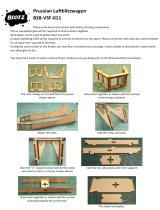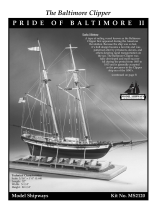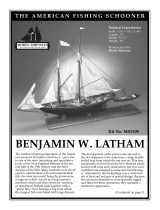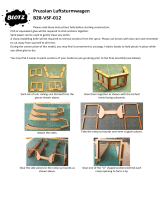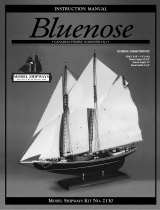Page is loading ...

Machine-guns with
shielding x 2
Machine-guns with
shielding x 2
Plank
Wire x 2
Loadline
• Metal glue
• Metal file
• Sandpaper (grain no. 800)
• Craft knife
• Double-sided adhesive
tape
• Pliers
• Putty
• Metal primer
• Wooden spatula
• Spray paint (battleship grey, iron
grey)
• Watercolour (battleship grey, matt
black)
Recommended tools and materials
Machine-guns with shielding and loadline
(starboard)
6
Cut the wire 4with the
pliers to get six pieces 6mm
in length. It will be easier to cut
the correct length if you take
piece 3and, as shown in the
photo, match one end of the
wire to it and secure with
double-sided adhesive tape
before cutting.
5
Holding the piece 1as
shown in the photo, fix to
piece 2with metal glue. You
have now made a base of a
machine-gun with shielding.
Assemble the other.
4
Checking against Step 5,
insert a piece 2in the central
cavity of a piece 1. If it does not
fit perfectly, smooth it with the
file and sandpaper, making it fit
perfectly to the curve of piece 1.
2
After an initial filing, smooth
with sandpaper grain no. 800,
being careful not to damage the
original shapes.Where the metal file
cannot reach, use the blade of the
craft knife, being careful not to
damage other parts of the pieces.
3
Correct any holes or hollows on
the surface of the pieces by
applying putty with the tip of the
craft knife, or plank. When the
putty is completely dry, smooth
with sandpaper grain no. 800.
1
Smooth pieces 1and 2 with
the metal file, eliminating
irregularities in shape. These
pieces have a rounded edge.
Checking against Figure A,
smooth with the file, taking
care to maintain the
rounded shape.
A
MACHINE-GUNS WITH SHIELDING
Yamato: Step-by-step 145

12
Take the bases of the
machine-guns with
shielding, as shown in the photo.
Mix equal parts of battleship grey
and matt black watercolour and
paint both cavities. Take care not to
let the paint go beyond the cavities.
7
Smooth the ends of the
wires 4 with the metal file,
so that they are all the same
length. You have now made the
barrels of the machine-guns.
10 Repeat several times from
different angles, allowing
the paint to dry thoroughly
between each coat.
11
Following Steps 8, 9 and
10, paint the barrels of the
machine-guns. After spraying
with metal primer, give several
light and even coats of iron grey
paint.
9
When the metal primer is
dry, spray a light and even
coat of battleship grey paint,
keeping the can about 30cm
away. Be careful not to fill in
the original details.
14
With the craft knife, cut a
groove 0.5mm deep along
the reference line previously drawn
on the starboard side.
13
Take the bases of the
machine-guns and insert the
barrels in the respective holes in
pieces 2. Apply fast-drying glue to
the tips of the barrels. Fix them
firmly. When ready, store the
machine-guns carefully. They will
be mounted in later stages of the
assembly.
15
Cut another groove 0.5mm-
deep in the stern hangar
along the lower edge of the rounded
part of the ship.
16
Similarly, make another
0.5mm-deep cut towards the
deck. Insert the tip of the craft knife
into the cut and shape the groove
into a ‘V’ shape (Figure B). Be
careful not to make the cut
too deep.
When using metal primer, ventilate the room well and follow the
instructions on the packaging.
When using spray paint, ventilate the room well and follow the
instructions on the packaging.
8Spray the metal primer
evenly on the bases of the
machine-guns with shielding
from a distance of about 30cm.
The operation will be simpler if
you secure the pieces to a base
with double-sided adhesive tape.
0.5mm
0.5mm
Cut as
described
in Steps 14
and 15
Bottom
of ship
B
LOADLINE (STARBOARD)
Yamato: Step-by-step 146

18
Stretch the loadline
(piece 5) by pulling with
the tips of your fingers. Make it
as straight as possible. Apply
fast-drying glue, and beginning
at the stern side, fix the loadline
in the groove. Take care not to
spread glue on the body of the
ship.
17
Use a round metal file to
give the groove a
semicircular shape. You can also
use sandpaper wrapped round a
thin rod. Take care not to
smooth excessively.
21
Cut a section of piece 5
to fit the sloping part of
the bow, and glue in place.
22
Following on from the parts
of the loadline glued in Steps
19 and 20, glue the remaining
loadline to the lower part of the
hangar. The left edge must align
with the loadline glued on top of
the hangar. Allow the glue to dry
and trim the excess with the pliers.
20When the glue is dry, cut
the excess loadline on
the stern side, taking care not to
cut too much.
23
Spray a coat of primer on
the sides of the hull and the
bottom of the ship. The operation
will be simpler if you support the
structure on a base.
19Glue piece 5to the point
where the line angles
downwards (red circle in the
photo).
24
Fill any gaps between the
hull and the loadline or the
joints with putty. Allow to dry and
remove any excess by smoothing
with sandpaper.
COMPLETED PIECES
LOADLINE (STARBOARD)
MACHINE-GUNS WITH
SHIELDING
When using metal primer, ventilate the room well and follow the
instructions on the packaging.
25
Check the holes of the
portholes. If any residue has
formed, remove it with the round
metal file, as shown in the photo.
Alternatively, you can use a thin rod
wrapped with sandpaper.
Yamato: Step-by-step 147

Machine-guns with
shielding x 2
Machine-guns with
shielding x 2
Plank
Wire x 2
Flat wire
• Metal glue
• Metal file
• Sandpaper (grain
no. 800)
• Craft knife
• Double-sided
adhesive tape
• Ruler
• Pliers
• Putty
• Wooden spatula
• Pencil
• Adhesive tape
• Metal primer
• Spray paint (battleship
grey, iron grey)
• Watercolour
(battleship grey, matt
black)
Recommended tools and materials
Machine-guns with shielding and
exhaust pipes (port)
31
Cut the wire 4with the
pliers to get six pieces
6mm in length. It will be easier
to cut the correct length if you
take piece 3and, as shown in the
photo, match one end of the wire
to it and secure with double-sided
adhesive tape.
30
Holding the piece 1, as
shown in the photo, fix to
piece 2with metal glue. You
have made a base of a machine-
gun with shielding. Assemble the
other one.
29
Checking against Step 5,
insert a piece 2in the
central cavity of a piece 1. If it
does not fit perfectly, smooth it
with the file and sandpaper,
making it fit perfectly to the
curve of piece 1.
27
After an initial filing,
smooth with sandpaper
grain no. 800, being careful not to
damage the original shape. Where
the metal file cannot reach, use the
blade of the craft knife, being
careful not to damage other parts
of the pieces.
28
Correct any holes or hollows
on the surface of the pieces
by applying putty with the tip of
the craft knife, or wooden spatula.
When the putty is completely dry,
smooth with sandpaper grain no.
800.
26
Smooth pieces 1and 2 with
the metal file, eliminating
irregularities in shape. These pieces
have a rounded edge. Checking
against Figure A, smooth with the
file, taking care to maintain the
shape.
A
MACHINE-GUNS WITH SHIELDING
Yamato: Step-by-step 148

37
Take the bases of the
machine-guns with
shielding, as shown in the photo.
Mix equal parts of battleship grey
and matt black watercolour paint
and paint both cavities. Take care
not to let the paint go beyond the
cavities.
32
After cutting to length,
smooth the ends of the
wires 4 with the metal file, so
that they are all the same length.
You have now made the barrels
of the machine-guns.
35Repeat several times from
different angles, allowing
the paint to dry thoroughly
between each coat.
36
Following Steps 33, 34
and 35, paint the barrels
of the machine-guns. After
spraying with metal primer, give
several light and even coats of
iron grey paint.
34
When the metal primer
is dry, spray a light and
even coat of battleship grey
paint, keeping the can about
30cm away. Be careful not to
fill in the original details.
39
Make the exhaust pipes
circled in red in Figure B.
On the port side plan of the hull,
lengthen the lines of the exhaust
pipes as far as the bridges.
38
Take the bases of the
machine-guns and insert the
barrels in the respective holes in
pieces 2. Apply metal glue to the
tips of the barrels. Fix them firmly.
When ready, store the machine-
guns carefully. They will be
mounted in later stages of the
assembly.
40
Place the plan on the port
side of the hull. Align it
lengthwise with reference to the
hangar area at the stern, and place it
parallel to and below the overhang
of the hull. Secure it with adhesive
tape. On the hull, make marks
indicating the location of the lines
made in Step 39.
41
After marking the positions
of the exhaust pipes in the
previous step, make marks for the
upper and lower ends. To help do
this accurately, make the tool shown
in the picture from cardboard.
When using metal primer, ventilate the room well and follow the
instructions on the packaging.
When using spray paint, ventilate the room well and follow the
instructions on the packaging.
33Spray the metal primer
evenly on the bases of the
machine-guns with shielding,
from a distance of about 30cm.
The operation will be simpler if
you secure the pieces to a base
with double-sided adhesive tape.
B
Place the top edge of the
drawing parallel below the
overhang of the hull.
Right angle
About 15 cm
About 3cm
About 3cm
About 12cm
EXHAUST PIPES (PORT)
Yamato: Step-by-step 149

43
Place the tool on the hull as
shown in the photo, fitting
the horizontal edge to the bottom of
the hull, and the vertical close to the
exhaust pipe on the forward side.
On the hull, make marks
corresponding to the lines drawn in
Step 42, then transfer the upper and
lower lines of all the exhaust pipes.
42
Remove the plan from the
hull, and rest the tool on it,
as shown in the photo. Align the
horizontal line of the tool with the
bottom of the hull, with the vertical
line closest to the exhaust on the
forward side. Transfer the positions
of the vertical lines of the pipes onto
the tool.
46
With fast-drying glue, fix the
piece cut in Step 45 to the
reference line on the hull. Take care
not to let the glue drip onto the
body of the ship.
47
Place the second exhaust
pipe starting from the
bow. As in Step 46, cut a section
equal in length to that specified
in the drawing and match it to
the reference line on the hull.
Pressing with your fingers,
shape the piece to the curve of
the hull.
45Using the craft knife, cut a
section of piece 5to the same
length as the exhaust pipe shown in
the drawing, on the forward side.
48
Once shaped, remove
the piece 5and adjust
the curve, using a strake to
make the angle more defined.
44 Stretch piece 5, pulling it
straight with your fingertips.
49
With fast-drying glue,
fix the piece adjusted in
Step 48 in the position shown
in Step 47. After positioning it,
press it with the end of a strake
so it fits to the ship perfectly.
50
As in Steps 47 to 49, fix
the other sections of
piece 5.
COMPLETED
PIECES
EXHAUST PIPES
(PORT)
MACHINE-GUNS WITH
SHIELDING
Make this line match the
hull bottom of the plan.
Yamato: Step-by-step 150

Machine-guns with
shielding x 2
Machine-guns with
shielding x 2
Plank
Wire x 2
Flat wire
• Metal glue
• Metal file
• Sandpaper (grain no.
800)
• Craft knife
• Double-sided
adhesive tape
• Ruler
• Pliers
• Putty
• Wooden spatula
• Metal primer
• Spray paint
(battleship grey,
iron grey)
• Watercolour (battleship
grey, matt black)
Recommended tools and materials
Machine-guns with shielding and
exhaust pipes (starboard)
56
Holding the piece 1, as
shown in the photo, fix to
piece 2with metal glue. You
have made a base of a machine-
gun with shielding. Assemble the
other one.
55
Checking against Step 56,
insert a piece 2in the
central cavity of a piece 1. If it
does not fit perfectly, smooth it
with the file and sandpaper to
make it fit perfectly to the curve
of piece 1.
54
Correct any holes or
hollows on the surface of
the pieces by applying putty
with the tip of the craft knife, or
wooden spatula. When the putty
is completely dry, smooth with
sandpaper grain no. 800.
52
After an initial filing,
smooth with sandpaper
grain no. 800, being careful not to
damage the original shape.
53
Where the metal file cannot
reach, use the blade of the
craft knife, taking care not to
damage other parts of the pieces.
51
Smooth pieces 1and 2 with
the metal file, eliminating
irregularities in shape. These pieces
have a rounded edge. Checking
against Figure A, smooth with
the file, taking care to
maintain the shape.
A
MACHINE-GUNS WITH SHIELDING
Yamato: Step-by-step 151

62
Following Steps 59, 60 and
61, paint the barrels of the
machine-guns. After spraying
with metal primer, give several
light and even coats of iron grey
paint.
57
Cut the wire 4with the
pliers to get six pieces
6mm in length. It will be easier
to cut the correct length if you
take piece 3and, as shown in
the photo, match one end of the
wire to it and secure with
double-sided adhesive tape.
60When the metal primer
is dry, spray a light and
even coat of battleship grey
paint, from a distance of about
30cm. Be careful not to fill in
the original details.
61
Repeat several times from
different angles, allowing
the paint to dry thoroughly
between each coat.
59
Spray the metal primer
evenly on the bases of the
machine-guns with shielding,
from a distance of about 30cm.
The operation will be simpler if
you secure the pieces to a base
with double-sided adhesive tape.
64
Take the bases of the
machine-guns and insert
the barrels in the respective holes
in pieces 2. Apply metal glue to
the tips of the barrels. Fix them
firmly. When ready, store the
machine-guns carefully. They will
be mounted in later stages of the
assembly.
63
Take the bases of the
machine-guns with
shielding, as shown in the photo.
Mix equal parts of battleship grey
and matt black watercolour paint
and paint both cavities. Take care
not to let the paint go beyond the
cavities.
65
Make the exhaust pipes
circled in red in Figure B.
On the starboard side plan of the
hull, lengthen the lines of the
exhaust pipes as far as the bridges.
66
Place the plan on the
starboard side of the hull.
Align it lengthwise with reference to
the hangar area at the stern, and
place it parallel to and under the
overhang of the hull. Secure it with
adhesive tape.On the hull, make
marks indicating the location of the
lines made in Step 65.
When using spray paint, ventilate the room well and follow the
instructions on the packaging.
When using metal primer, ventilate the room well and follow the
instructions on the packaging.
58After cutting to length,
smooth the ends of the
wires 4 with the metal file, so
that they are all the same length.
You have now made the barrels
of the machine-guns.
B
Place the top edge of the plan
parallel to and below the
overhang of the hull.
EXHAUST PIPES (STARBOARD)
Yamato: Step-by-step 152

68
Remove the plan from the
hull and rest the tool on
it, as shown in the photo. Align
the horizontal line of the tool
with the bottom of the hull, with
the vertical line closest to the
exhaust on the forward side.
Transfer the positions of the
vertical lines of the pipes onto
the tool.
67
After marking the
positions of the exhaust
pipes in the previous step, make
marks for the upper and lower
ends. To help do this accurately,
make the tool shown in the
picture from cardboard.
71
Using the craft knife, cut a
section of piece 5to the
same length as the exhaust pipe
shown in the drawing, on the
forward side.
72
With fast-drying glue, fix
the piece cut in Step 71 to
the reference line on the hull.
Take care not to let the glue drip
onto the body of the ship.
70 Stretch piece 5, pulling it
straight with the tips of
your fingers.
73
Place the second exhaust
pipe, starting from the bow.
As in Step 46, cut a section equal
in length to that specified in the
drawing and match it to the
reference line on the hull. Pressing
with your fingers, shape the piece
to the curve of the hull.
69Place the tool on the hull
as shown in the photo,
fitting the horizontal to the
bottom of the hull, and the
vertical close to the exhaust pipe
on the forward side. On the hull,
make marks corresponding to the
lines drawn in Step 68, then
transfer the upper and lower lines
of all the exhaust pipes.
74
Once shaped, remove the
piece 5and adjust the
curve, using a strake to make the
angle more defined.
75
With fast-drying glue, fix
the piece adjusted in Step
73 in the position shown in Step
74. After positioning it, press it
with the end of a strake so it fits
perfectly to the shape of the ship.
As in Steps 72 to 74, fix all the
other starboard pipes.
COMPLETED PIECES
EXHAUST PIPES (STARBOARD)
MACHINE-GUNS WITH
SHIELDING
Right angle
About 15cm
About 3cm
About 3cm
12cm circa
Align with the bottom
of the hull.
Yamato: Step-by-step 153

Base of the funnel
Wire
Slat x 6
Rolling chock x 4
• Sandpaper (grain nos. 240,
400 and 800)
• Metal file
• Craft knife
• Putty
• Double-sided adhesive
tape
• Pencil
• Set-square/ruler
• Wood glue
• Hand drill (diameter 0.5mm)
• Pliers
• Metal primer
• Wood primer
• Spray paint (battleship grey)
Recommended tools and materials
Base of the funnel and rolling chocks
81
Place the slat on a flat
surface and glue two
pieces 4, as shown in Figure A.
The flat side of pieces 4should
align with the reference line. The
bottom of the pieces 4should be
aligned with the lower edge of
piece 3. Use a ruler to make sure
the edges match exactly.
80
Take a slat 3and, in the
middle on both sides,
draw a perpendicular reference
line, as shown in the photo.
79
Remove the pieces 4
from the backing by
sliding the craft knife along the
grooves. After removing the
pieces, smooth the edges with
sandpaper grain no. 400.
When using spray paint, ventilate the room well
and follow the instructions on the packaging.
When using metal primer, ventilate the room well and follow the
instructions on the packaging.
77
Correct any holes or hollows
on the surface of the pieces
with putty. When this is completely
dry, smooth with sandpaper grain
no. 800, then spray evenly with metal
primer, from a distance of about
30cm. The operation will be simpler
if you secure the pieces to a base with
double-sided adhesive tape.
78
When the metal primer is
dry, spray a light and even
coat of battleship grey paint from a
distance of 30cm. Repeat several
times from different angles, letting
the paint dry thoroughly each time.
76
Smooth piece 1with the
metal file, eliminating
irregularities in shape. After an
initial filing, smooth again with
sandpaper no. 800, being careful
not to damage the original shape.
Where the file does not reach, use
the blade of the craft knife.
Draw a perpendicular
reference line in the
middle.
Reference
line
Line up the lower
edges by leaning
them against the
ruler.
ROLLING CHOCKS BASE OF THE FUNNEL
A
Yamato: Step-by-step 154

87
Shape the bottom of the
rolling chock as shown in
Figure D of Step 88. Using a craft
knife, scrape the right and left ends
of the piece, as well as the
bottom edge (Figure C).
82
Turn over the piece made
in Step 81, and with wood
glue, fix two more pieces 3, one
on each side. The left and right
ends of the pieces 4should extend
slightly beyond the end of the
slats.
85Turn over the piece made
in Step 84, positioning it as
shown in the photo. On the
surface of the slat, glue two pieces
4, following the same procedure
as in Step 81. Align the
bottom edge of the pieces 4
with that of the pieces 3
(Figure B).
86
When the glue is dry,
remove the parts of piece 3
that extend beyond the edge of
pieces 4. You have made a rolling
chock. Make one more.
84
Using the pieces of slat cut
in Step 83, reinforce the
left and right ends of the pieces 4.
Apply glue to both the pieces 4
and to the surface of the slat.
Once dry, cut the protruding
parts on the underside of the
pieces 4with the craft knife.
89
Spray all surfaces of the
rolling chock evenly with
wood primer, from a distance of
about 30cm. Allow to dry, and
gently smooth the surface with
sandpaper grain no. 800.
88
After an initial trim, finish
with sandpaper grain no.
240, then grain no. 400. Take care
not to smooth too much, and
ensure that the piece retains its
shape when viewed from the
side (Picture E).
90
Take the port-side plan and,
in the area of the hull
bottom, aligned with both ends of
the rolling chock, draw a vertical
line to the bottom line of the hull.
91
Take the hull and place the
plan against the port side.
Using the hangar area as reference,
position the plan so it is vertically
parallel to the bottom of the hull.
Transfer the line drawn in Step 90
onto the hull.
When using wood primer, ventilate the room well and follow the
instructions on the packaging.
83Turn over the piece made
in Step 82, as shown in the
photo, and with a craft knife, cut
the parts of the pieces 3
protruding beyond the bottom
edge of the pieces 4. The parts
that extend beyond the top edge
will be dealt with later. Keep the
pieces of slats for later use.
The pieces 4 wll protrude slightly.
Section
B
Section
Area to be
removed
C
Section
D
E
Yamato: Step-by-step 155

93
Join up the marks made
in Step 92, drawing a line
parallel to the bottom of the hull.
Use a leftover strake as a ruler.
92
Make a cardboard tool
(Figure F) and place it on
the hull, as shown in the photo, so
that the vertical line is about 5cm
from the end of the rolling chock
towards the centre of the hull.
Transfer the reference line
onto the hull. Repeat the
operation on the opposite end
of the chock.
96
Remove the rolling chock
from the hull. On each
mark drawn in Step 95, drill a
hole 3mm deep with the 0.5mm
bit. To ensure the holes are the
correct depth, wrap adhesive tape
3mm from the tip of the drill.
97
Following the procedure
described in Step 96, make a
hole 15mm below the horizontal
line of the marks made in Step 95
(Figure H).
95Make three marks on
both the chock and the
hull, the first 5cm from the tip of
the bow end of the rolling chock,
toward the centre of the hull.
Make the next about
5cm from the stern
end and the third
in the middle
(Figure G).
98
In the holes made in the
chock in Step 96, insert
piece 2and cut it with the pliers,
leaving 3mm of wire protruding
from the holes. Take care not to
damage the wire.
94Temporarily fix the rolling
chock to the hull with
double-sided adhesive tape. Align
the lower edge with the reference
lines drawn in Steps 92 and 93,
and use the marks of Step 91 as
reference for the right and left
ends. The side edges should
follow the shape of the hull.
99
Glue the rolling chock in the
position determined in Step
94. After applying glue to the flat
surface of the chock, attach it by
inserting the pieces 2placed in Step
98 into the holes in the hull.
100
Following Steps 90 to 99,
mount the starboard
rolling chock. Fill any gaps between
the hull and the chocks with putty,
using a wooden strake. When the
putty is completely dry, smooth with
sandpaper grain no. 400.
COMPLETED PIECES
BASE OF THE FUNNEL
ROLLING CHOCKS
Make a mark
about 3cm
about 15cm
3mm
Right angle
about 3cm
about 12cm
F
Make a mark on the rolling chock
and a T-shaped one upsidedown
on the hull
Keel
Mark
about 15cm
G
On the projection
of the vertical line,
at 1.5mm from
the horizontal line
Position of
the hole
H
Yamato: Step-by-step 156
/


